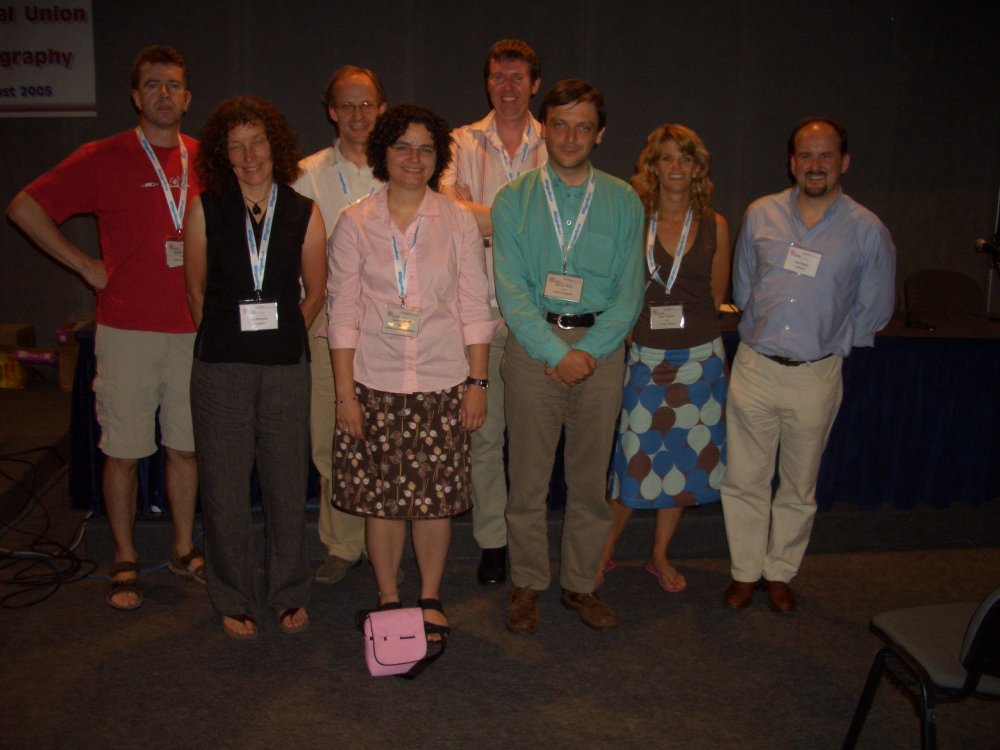Report on the Joint CCP4-RCSB PDB Workshop at the IUCr XX
Peter Briggs
CCP4, Daresbury Laboratory, Warrington WA4 4AD, UK
In a previous CCP4 newsletter (see
Newsletter 42) we reported on
the one-day CCP4 workshop held at the ACA meeting in Orlando Florida at the
start of the summer. We were pleased to be able to bookend the summer
conference season with a second one-day satellite workshop - this time a joint
effort between CCP4 and the RCSB PDB, at the XX IUCr Congress in Florence,
Italy. This workshop - entitled "A Protein Crystallographic Toolbox: CCP4
Software Suite and PDB Deposition Tools" - continues a tradition of
collaboration between the two projects. The workshop attracted around sixty
registered participants ranging from graduate students through to experienced
crystallographers, bringing with them a broad range of familiarity with the
CCP4 and RCSB software. The workshop followed our familiar format, with the
speakers (generally a mixture of software developers and expert users) giving
detailed user-focused presentations on the software in their area of expertise.
The presentations were intended to help novice users get started while at the
same time surprising more expert users with new or less-well known aspects of
the software.
After a brief joint introduction from Peter Briggs of CCP4
and Helen Berman of the RCSB-PDB, the first session concentrated on
giving a broad overview intended to lay the foundations for the later talks.
This included an introduction to the non-crystallographic "technical" aspects
of using the CCP4 suite and an excellent overview from Martin Noble of
the range of crystallographic functions in the suite. His tour of the suite
emphasised CCP4's "cradle to grave" coverage of the structure determination
process and its close integration with other non-CCP4 software packages.
The remaining presentations focused on practical aspects of the
software for key stages of structure determination and deposition. Gwyndaf Evans
covered data processing, integration and scaling using MOSFLM and SCALA,
including tell-tale signs which indicate whether data processing is working (hint:
look for sudden deviations from otherwise smoothly-varying behaviours) and how
to address various problem cases. Martyn Winn talked about refinement
with REFMAC5, focusing particularly on the use of TLS parameters. He
made a good case for trying TLS, as at worst it will make no difference to your
refinement while at best it can give a big improvement. Analysis of TLS values
may also be a useful tool in suggesting biologically significant protein domain
motions.
This was followed by impressive demonstrations by Liz Potterton
and Paul Emsley of two faces of CCP4's molecular graphics project, CCP4MG
and Coot respectively: the former currently focuses on providing
presentation-quality representations of molecular models, while the latter is a
platform for powerful model building tools. Both packages are now becoming
widely used and are already key tools in many macromolecular crystallographers'
toolkits (they will also both be available as part of the forthcoming CCP4 v6.0
release). Kyle Burkhardt of the RCSB-PDB closed appropriately by
focusing on the deposition of refined protein structures. She emphasised a
number of issues, including the existence of software tools to help make
deposition easier and the importance of validation prior to and during the
deposition process, and reminded the audience that the deposition sites want to
work with the authors to ensure the best possible representation of their data
in the archive.
The workshop closed with a summary of the most interesting
"bullet points" from each of the talks. Although the audience response was
muted (possibly due to the vastness of the Cimabue Room!) the feedback provided
via the questionnaires was very positive, and we were also pleased to see a
large percentage of younger crystallographers in attendence. Many people
reported that they found the presentations helpful and that they would be
trying out the software afterwards. As always there were also requests for a
longer workshop with more hands-on demonstrations and more examples of
real-life problems - we are of course interested in addressing these issues in
future (and in this regard CCP4 would also welcome any offers of help in
organising such workshops).
Next year we hope to be back at the
ACA in Hawai'i and at the
ECM in Leuven, Belgium.
The materials from this IUCr workshop can be found online via
http://www.ccp4.ac.uk/courses/IUCr2005/.
More information about CCP4 can be found at
http://www.ccp4.ac.uk and
about the RCSB PDB at http://www.rcsb.org/pdb/.

|
Acknowledgements
The workshop organisers Maeri Howard, Peter Briggs and Judy
Flippen-Anderson would like to thank the IUCr for the opportunity to run the
workshop, the speakers for their presentations and the delegates for attending.
We also wish to acknowledge the help of Annalisa Guerri in setting up the
workshop. Financial support was provided by CCLRC (from CCP4 industrial
income), the RCSB-PDB and from workshop registrations by the IUCr.
|
|
From back to front, left to right: Gwyndaf Evans, Martin Noble,
Peter Briggs, Maeri Howard, Paul Emsley, Liz Potterton, Kyle Burkhardt, Martyn
Winn
|
Peter Briggs (
p.j.briggs@dl.ac.uk) December 2005
